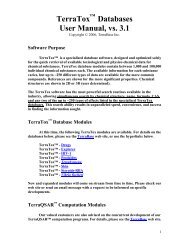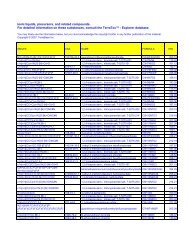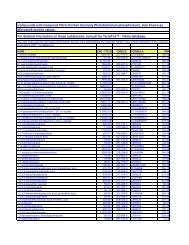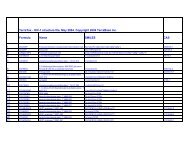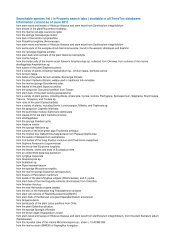Comparative Assessment of QSAR Models for Aquatic Toxicity
Comparative Assessment of QSAR Models for Aquatic Toxicity
Comparative Assessment of QSAR Models for Aquatic Toxicity
Create successful ePaper yourself
Turn your PDF publications into a flip-book with our unique Google optimized e-Paper software.
5. Estimation <strong>of</strong> predictive ability by internal validation techniques (cross-validation,bootstrap, response randomization).6. Evaluation <strong>of</strong> <strong>QSAR</strong> applicability domains by making predictions <strong>of</strong> SIDS test data:checking the domain <strong>of</strong> applicability with respect to descriptor ranges and any structuralrules defining the group <strong>of</strong> substances <strong>for</strong> which the models are valid.7. Application <strong>of</strong> the models to the SIDS chemicals8. Evaluation <strong>of</strong> predictive per<strong>for</strong>mance in terms <strong>of</strong> explained variance (Q 2 ext) and theprediction reliability (order <strong>of</strong> magnitude between estimated and experimental data).Predictive per<strong>for</strong>mance was assessed <strong>for</strong> the full set <strong>of</strong> SIDS substances, and <strong>for</strong> subsetsbased on different hypotheses about the applicability domain.9. <strong>Comparative</strong> analysis <strong>of</strong> the model quality.2. SIDS TOXICITY DATA SELECTIONThe experimental toxicity values were available <strong>for</strong> 32 SIDS chemicals; interval values wereprovided <strong>for</strong> 4 chemicals and open intervals (>) <strong>for</strong> 6 chemicals. All the measured effectconcentrations expressed as “>” were disregarded, since these values were difficult to comparewith <strong>QSAR</strong> predictions.In order to provide a deeper and more realistic further evaluation/validation <strong>of</strong> the selectedmodels the AQUIRE (AQUatic toxicity In<strong>for</strong>mation REtrieval) database developed by the U.S.EPA Mid-Continent Ecology Division, Duluth, MN (MED-Duluth)(http://www.epa.gov/ecotox/) was investigated to fill in the experimental missing values <strong>of</strong> theSIDS data.The AQUIRE database provided experimental toxicity values <strong>of</strong> 25 SIDS missing values. Sincethe database gave more than one value <strong>for</strong> each chemical the average value was used to fill in thedata gaps. Thus the final integrated SIDS dataset was made <strong>of</strong> 57 experimental toxicity data outthe 177 SIDS chemicals. The 177 SIDS chemicals investigated in this study, their toxicity interms <strong>of</strong> LogLC50(mol/l), their logKow values and their mechanism <strong>of</strong> action are listed in TableI.The mechanism <strong>of</strong> toxic action (MOA) <strong>of</strong> the SIDS chemicals was studied and identified bycomparing three classification schemes and developing a consensus classification scheme basedon a majority principle according to which each chemical has been classified belonging to theclass more represented among the classifications compared and following the precautionaryprinciple according to which all chemicals with a MOA differently interpreted by theclassification schemes were classified as potentially specifically reactive chemicals. The details<strong>of</strong> the three classification schemes compared together with the consensus classification schemeare illustrated in the European Commission Report EUR 21749 EN (Pavan, M. et al. 2005).2



